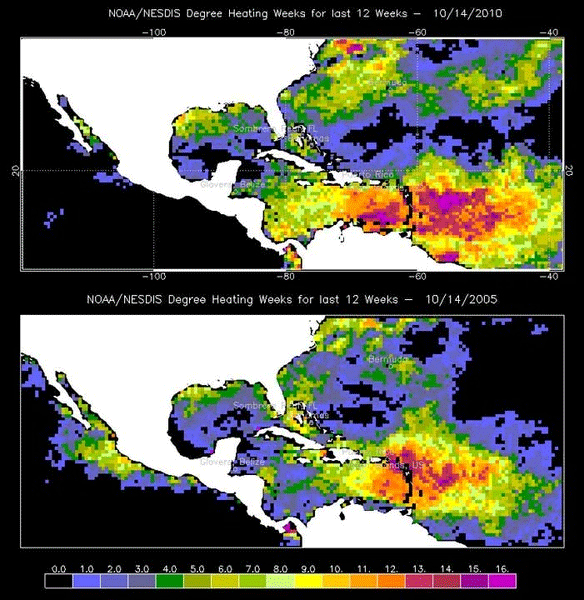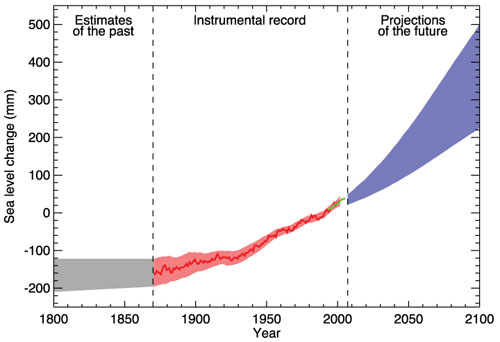Islands and Climate Change
While small island nations emit less than one percent of global greenhouse gas emissions, they are among the most vulnerable of all locations to the adverse effects of climate change and sea level rise. Climate change is expected to result in a variety of environmental, social, and economic effects on island states, including threats to natural habitats including coral reefs.
The severity and specific effects of climate change will differ from island to island, but for many small island states the sea level rises currently projected by the Intergovernmental Panel on Climate Change (IPCC) will result in major land loss. Islands are already at high risk due to their low-lying geography and vulnerability to natural disasters. Many islands sit just 3 to 4 meters above sea level, and even on islands at greater elevations, much of the economic activity and infrastructure is located near the coast.
Small islands often contain a highly unique range of biological diversity with over 4,000 species of endemic plants and animals, including some of the largest and most diverse coral reefs. Because of their small size and the endemic nature of many species, the biological diversity of small island states is extremely fragile. Small changes in air or sea surface temperature could have devastating effects on these unique plants and animals.
Higher sea surface temperatures and ocean acidification will lead to more extreme and widespread incidences of coral bleaching and coral mortality. Scientists studying Caribbean reefs say that 2010 may be the worst year ever for coral mortality. Abnormally warm water since June 2010 appears to have dealt a blow to shallow and deep-sea corals that is likely to top the devastation of 2005, when 80% of corals were bleached and as many as 40% died in areas of the Eastern Caribbean. But as this NOAA graphic shows, 2010 is worse than 2005:

Effects in the Cayman Islands
 The Cayman Islands are likely to be seriously affected by sea level rise as they are low-lying with an average height above sea level of just seven feet and lie in an area frequently affected by hurricanes. Forecast increases in the intensity of hurricanes and tropical storms will cause higher associated storm surges, worsening the effects of sea level rise leading to increased beach erosion and damage to coral reefs. Sea level rise and higher storm surges could also lead to the widespread destruction of mangroves, thus rendering the coastline even more vulnerable to flooding. The Cayman Islands are likely to be seriously affected by sea level rise as they are low-lying with an average height above sea level of just seven feet and lie in an area frequently affected by hurricanes. Forecast increases in the intensity of hurricanes and tropical storms will cause higher associated storm surges, worsening the effects of sea level rise leading to increased beach erosion and damage to coral reefs. Sea level rise and higher storm surges could also lead to the widespread destruction of mangroves, thus rendering the coastline even more vulnerable to flooding.
Rising sea level will also affect the built environment of the Cayman Islands including roads, aircraft runways, and port infrastructure. Many of the islands’ homes, resort hotels and condominium developments are built on the coastline and are extremely vulnerable to adverse weather and the resulting storm surge. Oil storage facilities are located along the coast in the midst of a residential area while Grand Cayman’s only airport is on the edge of North Sound bordering the coastal flood plain.
 Tourism accounts for a high proportion of the islands’ GDP and therefore any impact to the tourism industry is of vital consequence to the nation. Probably the most direct effect of rising relative sea levels on tourism will be the erosion and retreat of beaches and the consequent effect on beach properties. A sustainable approach to coastal defense is probably the most effective in the long run, with protection of the local mangroves playing a very important role in the protection and stability of the islands as they trap sediment and disrupt waves. It is for this reason that Island Offsets is working in partnership with the National Trust to purchase at-risk forests in the Cayman Islands to prevent deforestation of local ecosystems. Tourism accounts for a high proportion of the islands’ GDP and therefore any impact to the tourism industry is of vital consequence to the nation. Probably the most direct effect of rising relative sea levels on tourism will be the erosion and retreat of beaches and the consequent effect on beach properties. A sustainable approach to coastal defense is probably the most effective in the long run, with protection of the local mangroves playing a very important role in the protection and stability of the islands as they trap sediment and disrupt waves. It is for this reason that Island Offsets is working in partnership with the National Trust to purchase at-risk forests in the Cayman Islands to prevent deforestation of local ecosystems.
In view of the threat posed by rising sea levels, more intense hurricanes, and increased costs of foreign oil (both financial and environmental) it is evident that strong responses are needed. Island Offsets is working to ease and speed the transition to a renewable energy future for the Cayman Islands by helping to finance expensive changes to existing infrastructure and by increasing awareness of existing alternatives. 

Source: EPA
|